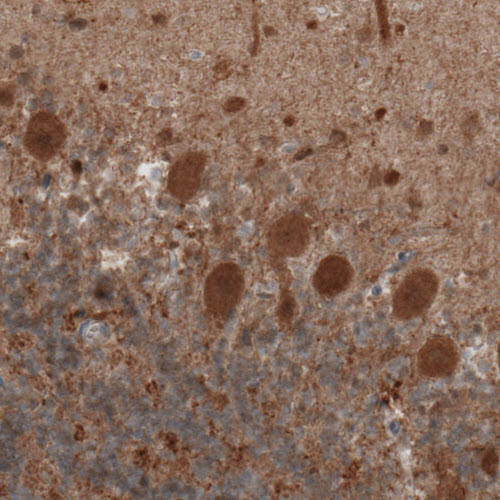Anti UCHL1 mAb (Clone CL3210, ATL-AMAb91145)
Atlas Antibodies
- Catalog No.:
- ATL-AMAb91145-25
- Shipping:
- Calculated at Checkout
$328.00
Gene Name: UCHL1
Alternative Gene Name: PGP9.5, PARK5, Uch-L1
Clone ID: CL3210
Isotype: IgG1
Interspecies mouse/rat: ENSMUSG00000029223: 97%, ENSRNOG00000002343: 97%
Entrez Gene ID: 7345
Uniprot ID: P09936
Buffer: 40% glycerol and PBS (pH 7.2). 0.02% sodium azide is added as preservative.
Storage Temperature: Store at +4°C for short term storage. Long time storage is recommended at -20°C.
| Product Specifications | |
| Application | WB, ICC, IHC |
| Reactivity | Human, Mouse, Rat |
| Clonality | Monoclonal IgG1 (Clone No.: CL3210) |
| Host | Mouse |
| Gene ID - Mouse | ENSMUSG00000029223 |
| Gene ID - Rat | ENSRNOG00000002343 |
| Buffer | 40% glycerol and PBS (pH 7.2). 0.02% sodium azide is added as preservative. |
| Documents & Links for Anti UCHL1 mAb (Clone CL3210, ATL-AMAb91145) | |
| Datasheet | Anti UCHL1 mAb (Clone CL3210, ATL-AMAb91145) Datasheet (External Link) |
| Vendor Page | Anti UCHL1 mAb (Clone CL3210, ATL-AMAb91145) at Atlas Antibodies |
| Documents & Links for Anti UCHL1 mAb (Clone CL3210, ATL-AMAb91145) | |
| Datasheet | Anti UCHL1 mAb (Clone CL3210, ATL-AMAb91145) Datasheet (External Link) |
| Vendor Page | Anti UCHL1 mAb (Clone CL3210, ATL-AMAb91145) |
| Citations for Anti UCHL1 mAb (Clone CL3210, ATL-AMAb91145) – 1 Found |
| Liu, Jiang-Ping; Jing, Hong-Bo; Xi, Ke; Zhang, Zi-Xian; Jin, Zi-Run; Cai, Si-Qing; Tian, Yue; Cai, Jie; Xing, Guo-Gang. Contribution of TRESK two-pore domain potassium channel to bone cancer-induced spontaneous pain and evoked cutaneous pain in rats. Molecular Pain. 2021;17( 34102915):17448069211023230. PubMed |




![Lane 1: Marker [kDa] 250, 130, 100, 70, 55, 35, 25, 15, 10<br/>Lane 2: Human cell line U-251 AAb Lane 1: Marker [kDa] 250, 130, 100, 70, 55, 35, 25, 15, 10<br/>Lane 2: Human cell line U-251 AAb](https://cdn11.bigcommerce.com/s-ydswqc5qsc/images/stencil/500x659/products/58192/144886/atl-amab91145_anti-uchl1-mab-clone-cl3210-atl-amab91145_26509__27276.1681093262.jpg?c=2)